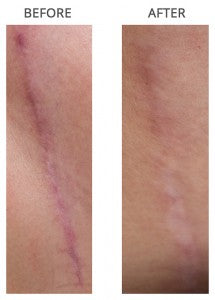Scar 101
How are scars formed?
Scars are usually formed from a trauma or injury. This can be the result of surgery, a burn or an accident. Anything that causes the skin to break will cause a scar, and in some people the scars will get better. In a large proportion of people, the scars will remain red and raised and these need to be treated with a safe effective product that is clinically proven work. Some people heal slower than others and they are more likely to get scars.
What are the different types of scars?
ATROPHIC SCARS
These scars are usually indented and result from acne or chicken pox. These scars are notoriously difficult to treat and most of the non-medical grade silicone gels on the market will not be effective against these scars.
BURN SCARS
The majority of burns will cause scars as they tend to heal slower than most other types of wounds. Burn scars are actually hypertrophic scars. Early treatment is recommended and the use of silicone scar gel plus massage normally produces the best outcome.




HYPERTROPHIC SCARS
The majority of people that scar develop Hypertrophic scars. These are red and raised, generally along the length of the injury.
KELOIDS
Keloids are a different type of scar to the above and tend to be harder to treat. Keloids are normally formed after a trauma or wound, but spread away from the original wound. Very light skin and very dark skin tend to be more prone to Keloids and it is believed to be a genetic link to the formation of keloids.
If the scar is still red and raised after 2 weeks then the medical grade silicone scar gel should be used to reduce the redness and flatten the scars. It is critical if the patients scar easily or have family members that scar. Early use of medical grade silicone gel as soon as the skin has healed has been clinically proven to prevent scar formation.
Important Tips:
-
All scars get worse in the sun. As humans, it’s difficult to completely avoid the sun so do your best and always apply SPF30+ sunscreen and/or cover your score as much as possible if concerned with your scar.
-
As well as using ScarMD® Scar Gel & Spray, massage the scar with a simple moisturizing cream. Use a simple cream with no perfumes or additives in.
-
Don’t massage ScarMD® Scar Gel & Spray into the area. Apply a thin layer and leave it to dry.
-
If you have a history of scarring then use ScarMD® Scar Gel & Spray as soon as the wound has healed. Early use of ScarMD® Scar Gel has been proven to reduce the chance of scars developing by up to 60%.5
-
If you think that you have a Keloid scar then speak to a Dermatologist, Plastic Surgeon or Scar Specialist, who will advise the best combination treatments to use with ScarMD® Scar Gel & Spray.


